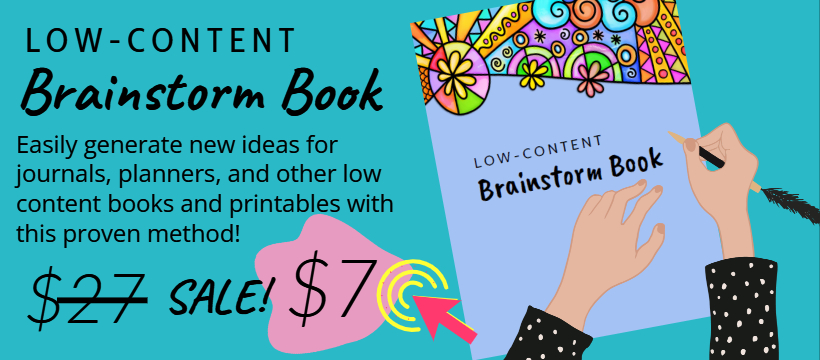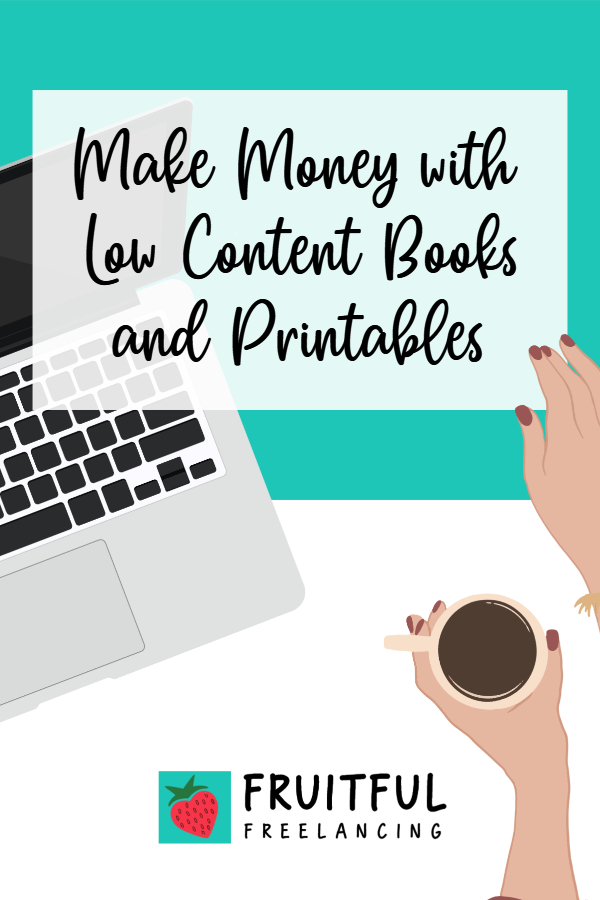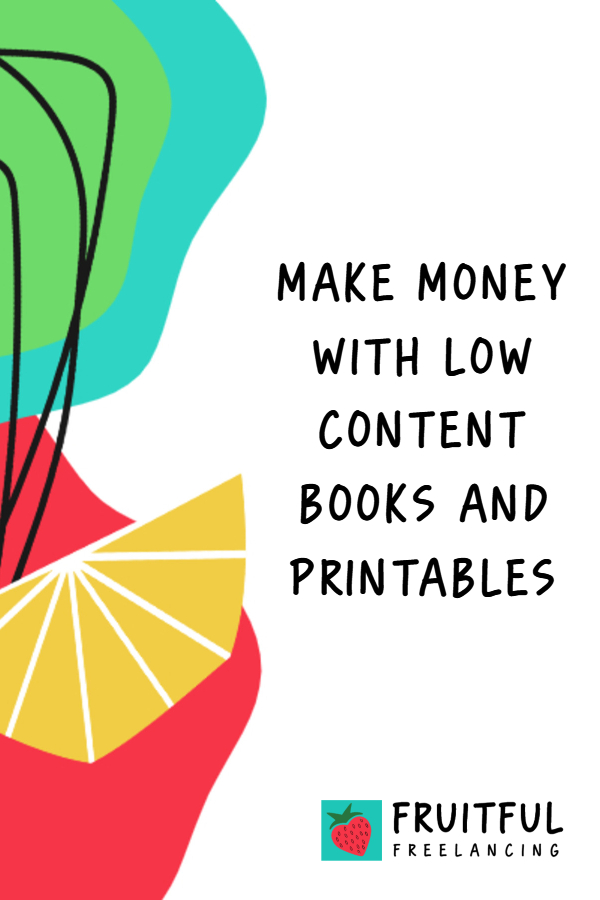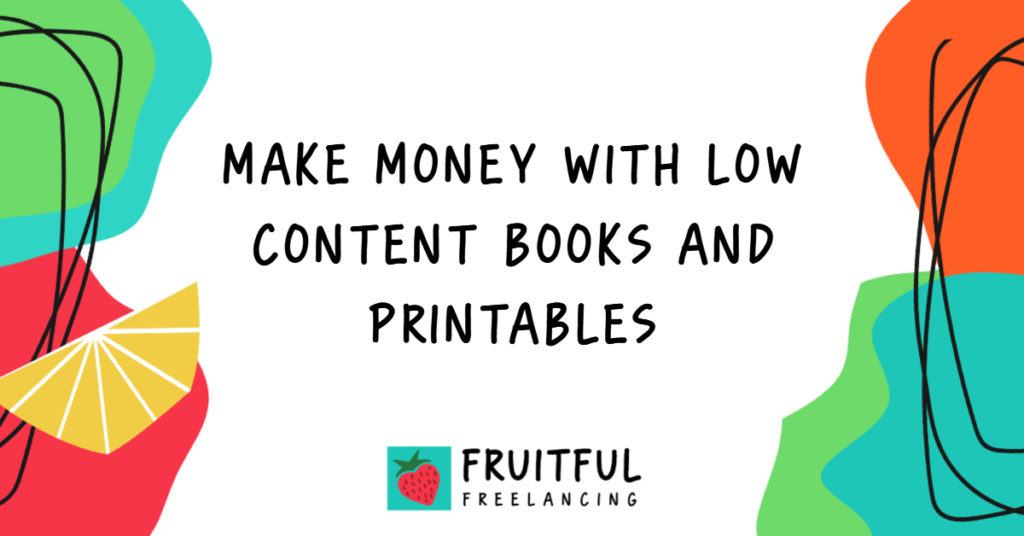What are “low content books?” What are “printables”? And why would someone who is good at writing try these ventures? Writers who also have design talents find that these projects are fulfilling to create. Plus, they leave more time for the necessary copywriting and marketing needed to bring in the cash. And, because products are delivered digitally, you don’t need to invest money in inventory, nor spend time shipping a physical product. Marketplaces like Amazon KDP and Etsy even take care of collecting sales tax. This reduces time spent on administrative tasks and leaves more time for the fun of creating.
What are low content books?
Low content books are primarily journals, diaries, planners, log books, and workbooks. And most include at least a small amount of content and space for the user to write. Guided journals, for example, include prompts which provide a focal point for writing and reflection. Most successful low-content books add value for the consumer by providing a framework to organize their thoughts or information.
What are printables?
Printables are digital files which the seller offers for purchase to end users. Buyers will print them out and use them for their personal use. Typical printables include journals, calendars, planners, and other paper systems for organization. Printables are also educational worksheets, workbooks, and coloring books, for children and adults. They can include resume templates, invitations and birth announcements, and posters.
While we are at it, what are digital planners?
While we are at it, let’s explain digital planners. Publishers sell the planners in the form of digital files for use with apps for tablet computers. Popular apps for digital planners are GoodNotes or Microsoft’s OneNote. The apps make a pdf usable similar to a printable planner. The user can write notes with a stylus and save them on their portable devices.
Why create low content books and printables?
Why would a writer produce low content books and printables? This may be a good fit for the writer also also enjoys design and organizing information. Because they don’t involve much writing, the time to market for these products is shorter. As with any items for sale, there is still writing involved in product listings or sales page copy.
The steps from concept to market
- Research
Many sellers of printables use Etsy to host their stores. Many sellers of low-content books sell their books on Amazon. Both these marketplaces have the advantage of built-in buyer traffic. To maximize success it is important to create products for which there is already a market. Describe these products using keywords which have a strong search volume but not too many providers. It’s important to begin each project with keyword research to give your creation the highest possible chance of success.
- Product creation
Next, produce print-ready products, This used to require access to expensive software as well as skills to use it. Now, publishers can create books and printables with lower-cost and familiar Microsoft PowerPoint or even free Google Slides and Canva. Affinity Publisher is affordable publishing software which has many of the professional-grade features of Adobe InDesign, the industry standard.
- Outsourcing product creation
Many creative people generate more ideas than they can carry out on their own. To bring your visions to life quickly it may make sense to hire design help. You may find designers for hire on Upwork, Fiverr, and other marketplace sites, or through word of mouth. The publisher might want to outsource Pinterest, Instagram, Facebook, and other social media images, ad graphics, and/or product mock-ups.
- Use Private Label Rights content and templates to speed up product creation
There are many Private Label Rights (PLR) content providers who specialize in the low-content publishing and printables markets. They provide templates for journals, planners, workbooks, and the like. They sell the editable files with rights to modify the files and sell the finished, non-editable files as your own. Starting with PLR content can save a lot of time, significantly speeding-up time to market. Amazon’s terms and conditions don’t allow the sale of Private Label Rights content on their platform as is. The publisher has to make significant rewrites and edits in order to make the book unique. Always read the terms and conditions for the PLR products you purchase. Know what you are and aren’t allowed to do with it.
- Purchase fonts and graphics with commercial use rights
There are many graphic design marketplaces which sell fonts and graphics which can be incorporated into your products for resale. Be sure that you are purchasing commercial use rights, and note the license terms. Mostly you are not allowed to use graphics “as is”. You must combine them with other graphics and elements to make a unique product. Some font and graphics licenses limit the quantity of end products which may be sold. If your product is a best seller, you may have to upgrade to an extended commercial license.
- Use software to speed production time
Various software is available to speed the creation of low-content books, including journal creation software and puzzle book creation software. These tools allow you to upload journal prompts or word lists. With the click of a few buttons, download print-ready pages to insert into your books. Again, read the terms of service to make sure you are using the outputs in acceptable ways.
- Upload files to Etsy or Amazon and complete the listing
Prepare product files (typically a printable flattened .pdf format for printables, and contents and cover files for Amazon’s KDP). Then write your keyword, category, and product listing verbiage. Now it is time to upload. Depending on the platform, there may be an approval process before your product is available for sale.
- Boost product sales by driving traffic
The advantage of sites like Etsy and Amazon is they already have a lot of buyer traffic. (The disadvantage is that both these platforms take a share of the profits.) Some sellers of printables and low-content books don’t have to do very much marketing because of their careful research. They are able to attract organic traffic and sales. Others find that marketing efforts to drive traffic to their offers pays off.
Marketing can take the form of advertising on these sites. Etsy and Amazon both sell ads. Some drive traffic using Pinterest pins and other social media posts. Pinterest, Facebook, and YouTube advertising can increase sales. If you have a blog which gets a lot of traffic, you can send that traffic to your products. Building an email list of your happy customers will let you promote your new products to them.
Enjoy your success publishing printables and low content books
Many publishers of printables and low content books report that the work is fun. Some even considering it play rather than work. Isn’t that what we all aspire to?
Resources for Low Content publishing
Low content book ideas
Low content book publishers sometimes have a hard time coming up with new ideas for books. The Low Content Brainstorm Book is a wonderful resource to help publishers come up with unique and clever ideas for new books. This 26-page workbook isn’t just a list of someone else’s ideas. Instead, it walks you through prompts to help you generate creative new low content book ideas that are completely your own. You can use the same ideas to create printable products too. (Because you are reading this, take $20 off with coupon code BRAINSFOR7.)

Click to learn more: Low Content Brainstorm Book
Market Research for Low Content Publishers delivered monthly
Many low content publishers get stuck when it comes to research. It takes time to research low content books and printables which are trending, the ones that Amazon is showing to potential buyers. It is easy to either get distracted into a research rabbit hole or to get bogged down and stuck rather than energized and inspired. Low Content Intel is a monthly research report which delivers just the right amount of fresh information about the KDP low content market, presented in colorful charts and graphs. Each report covers titles, subtitles, cover design, categories, keywords, descriptions, book marketing and more, and is available by single copy, or monthly or annual subscription.
Click to learn more: Low Content Intel
Share this article on Pinterest




Thank you Amy for sharing such helpful information for small biz owners! Beautiful job!!!
Thanks Karen!
Amy – thanks for a thorough and complete explanation about low-content books, printables, and digital planners. You have provided me with a lot of valuable information, and I appreciate your insights.
I am still trying to determine if low-content books, printables, and digital planners are right for me and my business. I know that they can be a great way to provide value to my customers, but I’m not sure if they are the best fit for my business model. I appreciate your help in determining if low-content books, printables, and digital planners are right for me. You gave a lot of ways they can be used – I just need to try it out and see if they work for me.
This is great, Amy! And so perfectly timed for what I need. I’ve been trying to think of content upgrades for my own site and your post has given me a few ideas… I love how clearly you explained what each item is and the process for getting started.
I learned so much about low-content, printables and how to more easily incorporate these into a business or start a side line! I had heard all the terms and thought I understood, but your examples and clear descriptions really helped.
Do you recommend starting an Etsy shop under an existing brand/biz name or something different?
Thanks, Jennifer. If your Etsy shop will be stocked with products closely tied to your business, then I would take advantage of the branding you have built to brand your shop. For example, a business coach might sell mugs or wall art printed with inspirational messaging, planners, workbooks, templates, or even ebooks or courses on Etsy. She or he could create a subdomain like “shop.maindomain.com and point that to the Etsy shop. Some solopreneurs like to have an Etsy shop as a side-hustle, an extra revenue stream that’s unrelated to their main business. In that case, I would choose a different name.
Thank you for this valuable information. I’ve been dipping my toe into low-content publishing for about a year, but I have not used my blog to drive traffic. It’s been totally separate. After reading your article, I am going to start driving traffic from my site to my KDP offerings and my Esty store.
Thanks again!!
Great post! Your advice about driving traffic to low content products is spot on. I also love how you show hew low-content products can be easily incorporated into any business.
Fab post that covers all the bases. I think most online businesses could add low-content products into the mix. I’m sure your post will open a lot of people’s eyes!
Great tips! I want to create some planners.
I didn’t realize how much confusion there is around the term “low-content” until I was reading a discussion in a Facebook group recently. This is a great overview though. I’ll be sharing this with some of the groups I’m in. Thanks, Amy! 🙂
Great ideas to help people get products to their specific market quickly and easily! Thanks!
Amy, this is a great article full of ideas and sparks for more streams of income.
Thanks for breaking down all those terms in one place–it seems to get confusing what’s low content or definition of a printable vs digital planner vs journals. Thanks for giving us a comprehensive description to clear up the confusion finally!